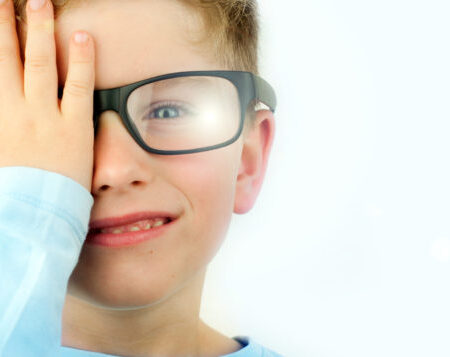More than 80% of what is taught in school to children is presented visually, so it’s important that children’s vision problems are detected and treated early before negative repercussions occur. For example, undetected vision problems in children can lead to misdiagnosed attention, behavioral, or reading issues. Signs of potential vision problems can differ by age, and also be broken down into physical traits, behavior, and what children say when they start talking.
Signs of Vision Problems by Age
Ages 3 months to 1-Year-Old
At around 3 months, babies should be able to follow or track an object (e.g. toy or ball) with their eyes as it moves across their field of vision. An inability to track and also not being able to hold steady eye contact are signs of vision problems in babies. While some infants have slightly misaligned eyes (crossed or one looks out), this should clear up by 4-6 months. Misaligned eyes in children can lead to amblyopia (lazy eye), a condition that needs to be treated to avoid more serious eye problems.
All Ages
- Extreme light sensitivity (e.g. indoor light, sunlight, or camera flashes)
- Poor visual tracking
- Poor focusing
- Chronically watery or red eyes
- White instead of dark pupils
- Drooping eyelids
- Red-rimmed, crusted, or swollen eyelids
Things Children with Vision Problems May Say or Do
Certain things children say can indicate potential vision problems. For example, they may say: my eyes are itchy, burning, or feel scratchy. They can also say more obvious things, such as I can’t see very well, I’m seeing double, or everything looks blurry. A little less obvious, children who complain about feeling dizzy, sick/nauseous, or having a headache after doing close-up work likely have a vision problem.
Children of all ages can exhibit specific behaviors that suggest a vision problem, such as rubbing their eyes constantly, tilting the head or thrusting it forward, and blinking or squinting frequently. School-age children and some preschoolers may have trouble reading or other close-up work, in addition to losing their place in a book, even when using their fingers. Additional behaviors at school that imply vision problems include trouble reading the blackboard and receiving lower grades than expected. Closing or covering one eye to read or watch television is a possible sign of convergence insufficiency while holding objects close to one’s eyes or consistently sitting close to the television is a possible sign of nearsightedness.
Common Eye Problems in Children
Amblyopia (lazy eye): Although it looks normal, vision in one eye is reduced because it isn’t working properly with the brain. If left untreated, amblyopia can cause irreversible visual loss in the impacted eye. Ideally, it should be treated before a child is age 8, typically by covering the stronger eye with an eye patch for weeks to several months. Patching stimulates the weaker eye and parts of the brain involved in a vision to develop more completely.
Strabismus: Although it can cause amblyopia and treatment is similar, strabismus is a different condition related to misalignment of the eyes. They can be turned in, out, up, or down. When detected early, vision can be restored by patching the properly aligned eye, forcing the misaligned one to work. Surgery or specially designed glasses may be required to help the eyes align.
Refractive errors: Like adults, children can experience refractive errors that require eyeglasses or contact lenses. Nearsightedness (myopia) is a condition in which distant objects appear blurry, while close objects are sharp. Although it’s rare in babies, myopia is becoming increasingly common in school-age children. Farsightedness (hyperopia) means you have difficulty seeing close objects, while distant objects are sharp.
It’s not uncommon for parents to miss more subtle signs of vision problems in their children. Eye problems often aren’t diagnosed at the pediatrician’s office, and school vision screenings can miss these issues as well. As such, experts advise that children should have their first eye exam at 6 months, again at age 3, and regular exams after starting school.
Sources:
https://www.allaboutvision.com/parents/slideshow-warning-signs.htm
https://www.preventblindness.org/signs-possible-eye-problems-children
https://www.healthychildren.org/English/health-issues/conditions/eyes/Pages/Warning-Signs-of-Vison-Problems-in-Children.aspx
https://kidshealth.org/en/parents/vision.html
Subscribe to our email newsletter to get the latest posts delivered right to your email.

